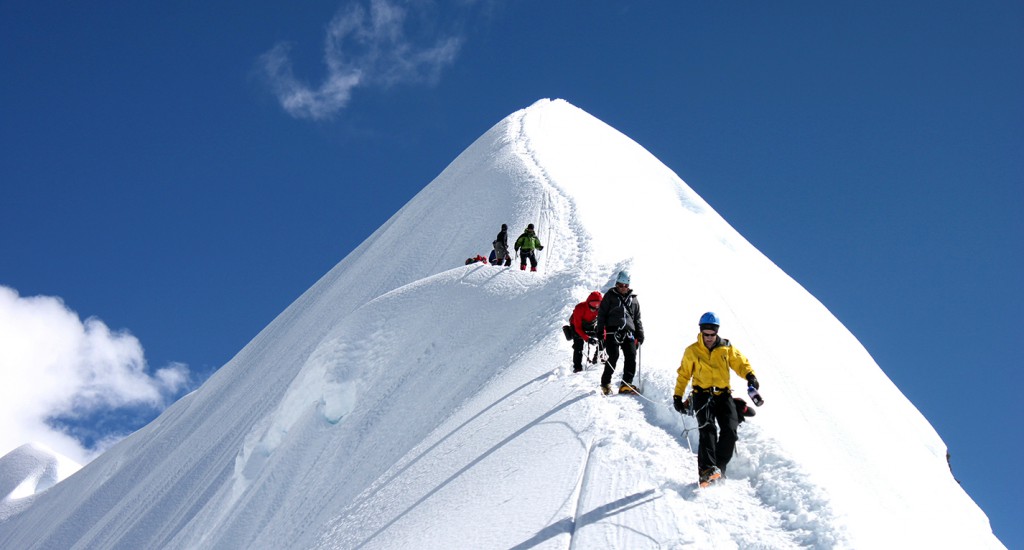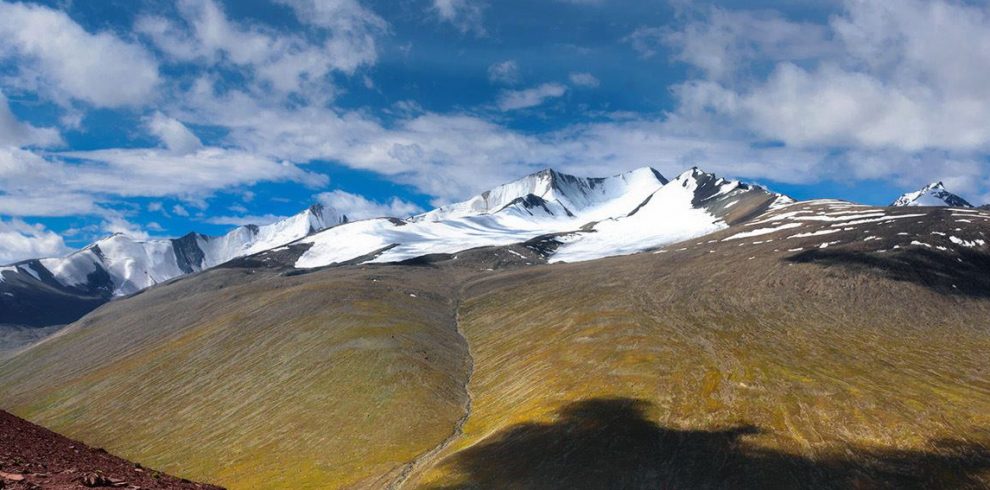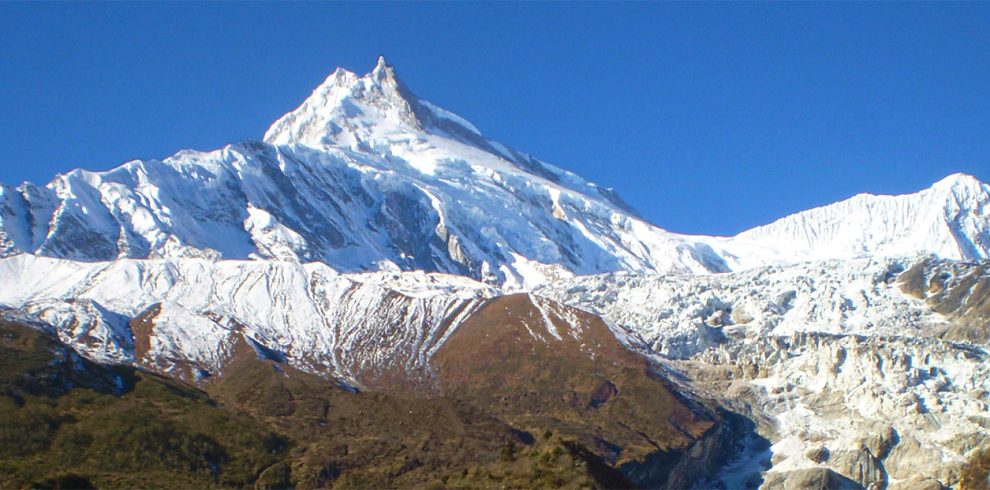Island Peak provides a superb introduction into Himalayan climbing. A 6189 m summit with a challenging 45 to 50 degree wall and breathtaking view of Mt. Lhotse, Mt. Ama Dablam, Mt. Makalu and surrounding peaks makes this one of the most popular climbing peaks in the Himalayas.
We begin this expedition with an acclimatization trek through the famous Khumbu Valley to Everest Base Camp. Along with Everest Base Camp, you also get an opportunity to climb Kalapathar (5545m), the best vantage point of Mt. Everest and its surrounding mountains. This will also be an essential step for acclimatization and mental preparation for the real challenge of climbing Island Peak.
After completion of the acclimatization trek, we trek to Island peak Base Camp. A few days are spent here for further acclimatization and training to prepare for the final summit push. We set up an advanced base camp to make it further achievable.
Overview
The summit climb begins with a moderate scrambling through a gully which is basically some rocky steps. It is followed with a glacier crossing which requires crampons and ropes. At the head of the glacier there is a steep wall of ice which is about 45 to 50 degrees slope which we climb on fixed ropes. Once we are over the wall we climb the beautiful ridge that this mountain is famous for, following to the summit.
Map
Himalayan Mountaineering
Ever since the Himalaya in Nepal has been opened for climbing, it has attracted thousands of mountaineers. Thousands of people have challenged their minds and bodies to conquer these magnificent mountains.
Nepal Himalaya has numerous of mountains which are 7 000 m and higher, which require extensive technical experience and a lot of money to climb. Apart from these technical expedition peaks, there was created in 1978, under the control of the Nepal Mountaineering Association (NMA), a list of mountains, between 5 587 m to 6 654 m, called “Trekking Peaks”. Unlike the technical expedition peaks, which are a complicated and an expensive affair, these “trekking peaks” can be climbed without financial and administrative problems. There are 1 310 identified peaks which are above 6 000 m, one fourth are officially opened for mountaineering.
Island Peak
Island Peak was so named by the legendary explorer Eric Shipton due to its striking location, like an island in a sea of ice. It stands in the middle of three glaciers with the Lhotse Glacier on its north, the Lhotse Shar Glacier to the east and the Imja Glacier on the south.
We begin with a spectacular mountain flight to Lukla (2859m). Trekking through the beautiful alpine forests, high altitude pastures and glaciers, staying in villages set on the lap of the soaring jagged peaks, we reach Everest Base Camp. You also get an opportunity to climb Kalapathar (5545m), the best vantage point of Mt. Everest and its surrounding mountains.
After completion of the acclimatization trek, we trek to Island peak Base Camp. All accommodation while trekking are in comfortable lodges, but for the climb we establish a tented Base Camp. A couple of days at Base Camp are allowed for rest and preparation during which relevant skills will be taught or revised that are necessary for the climb.
From Advance Base Camp we climb through a gully which is basically some rocky steps requiring moderate scrambling. At the top of the gully, we put on our crampons and glacier travel begins which proceeds up to a steep snow and ice slope. From here, we climb on fixed ropes set up by our guides for the strenuous ascent of nearly 100 meters. This is the most difficult part of our climb, which is about 45 to 50 degrees slope. Once we are over the wall we climb the ridge following to the summit.
Although no previous climbing experience is required you must be very fit and have extensive outdoor experience to participate in this Expedition.
Grading: This expedition is graded 6 which is equivalent to extremely demanding and challenging. Participants should have at least a basic knowledge of the use of ice axe and crampons, though first time climbers maybe accepted, provided she/he is very fit. We strongly recommend you to undergo extensive physical training at least 4 months prior to the expedition.
Please note: Any ascent of a Himalayan peak must be taken seriously. The Group leader will take all factors concerning group fitness and acclimatization, weather and snow condition into consideration when making a decision. While recognizing that this ascent is important to the group, first priority will always be safety. The decision on whether or not you will be able to attempt Lobuche Peak rest with the Group Leader. His/ her decision is final and must be accepted.
A Day on Your Trek
Although each day is different, considering the weather, general pace of the group and length of the days walk, in general your day begins with a wake up tea at around 6 to 6:30 in the morning. You will then be provided with a bowl of warm water for washing. Then you will need to pack your duffel bag and your daypack and come to the lodge’s diner for breakfast.
After breakfast we will hit the trail and usually walk for about 3 to 4 hours before we stop for lunch. We will give you about an hour and a half rest during lunch, which will also give enough time for the staff to have their lunch and pack. Usually after 3 to 4 hours of walking we finish the days walk by 4 PM. Tea/ Coffee and snacks will be served on arrival to the lodge. Your group Leader will often organize side trips in the afternoon. Your dinner will be served around 7 PM.
High Altitude
On this trek you will be going up to 6476m, so it is very important to understand the affects of altitude. The greatest provocation is going too high too fast. Hi On Life’s itinerary has been carefully designed to minimize the effects of altitude. We ascend slowly and surely allowing enough time for safe acclimatization.
Headaches and breathlessness are common at altitude which in itself is nothing to worry about. In rare cases, this may worsen to Acute Mountain sickness (AMS), so a close watch is kept on all trekkers by the group leader who is trained to recognize the symptoms of AMS which are severe headaches, nausea, lethargy, loss of appetite serious breathlessness even at rest. If any trekkers show such signs they will be descended to relatively lower and safer altitude. The Group Leader’s decision on evacuating such person to a safe altitude is final. Do not medicate yourself without first informing your group leader. Going to altitude slowly with adequate rest and adequate intake of fluid (3 to 4 litres per day), you will most likely have no problems apart from breathlessness on hills which is completely normal as the percentage of Oxygen in the air is relatively lower to that at sea level. The most important thing is not to worry about altitude because our team is there to take care of you.
Staff
Group leader: your most important member of your staff. Our Group leaders are highly trained in all aspects of the trek, conservation, first aid specializing on altitude sickness, emergency procedures and have extensive knowledge of the natural history of the area.
Sirdar: His job is to manage and organize staff duties. He is responsible for the actual operation of the trek.
Sherpas: Their job is to lead your way and distribute equal loads to the porters.
Cook: Responsible for your food. Hygiene of a high standard is taken into consideration in preparing the food.
Porters: They are responsible to transport your duffle bags and their job finishes once they reach the designated lodge. Our porters are provided with Gore-Tex suits, trekking boots, gloves, hats, socks, snow gaiters and snow goggles. Most importantly, we regulate them on a 25 Kg carrying which no other company does. Our clients can therefore feel comfortable knowing that our porters are working in a good humane condition. During the trek you can see porters carrying 60-70 kg and sometimes even more than 100 kg!!)
Weather:
Oct/Nov and March/April
On the trek at lower altitude (2500m to 3500m) during daytime the Max temp can be around 10C to 15C and the Min temp can be 3C to 7C
At higher altitude (4000m to 5000m) the daytime Max temp can be between 2C to 7C and Min temp can be between -8C to -2C
On your summit day: You can expect between -12C to -16C + wind chill factor depending on the wind speed
Dec to end of Feb
On the trek at lower altitude (2500m to 3500m) during daytime the Max temp can be around 0C to 5C and the Min temp can be – 5C to 2C
At higher altitude (4900m to 5000m) the daytime Max temp can be between -5C to 0C and Min temp can be between -10 C to -20C
On your summit day: You can expect between -15C to -20C + wind chill factor depending on the wind speed
Please note that this is just general information and it could vary.
Recommendations for things you should bring:
Clothing:
Head:
- Warm hat wool or synthetic that covers your ears
- Balaclava
- Sunhat
- Glacier sunglasses with side shields, 1 pair ski goggles (optional)
- Headlamp with extra batteries
- Buff or head scarf, also useful for dusty conditions
- 2 polypropylene or wool mix t-shirts
- 2 polypropylene or wool mix long sleeve t-shirts
- 2 long sleeve thermal underwear shirts, lightweight preferably woolen
- 1 polar fleece pullovers medium weight or 1 heavy wool thermal underwear
- 1 polar fleece jacket, OR Primaloft/ Down light weight jacket
- Gore-Tex jacket with hood, waterproof and breathable
- For high altitude use, 1 very warm goose-down jacket with hood (we provide this)
Hands:
For trekking:
- 1 pair light weight windstopper gloves
For climbing:
- 1 pr. lightweight poly-liner gloves
- 1 pair mittens, consists of 1 Gore-tex over mitt matched with the very warm polar Fleece mitt liner OR down gloves
Lower Body:
- 1 pair walking shorts
- 1 to 2 pair walking trousers for trekking
- 2 pair lightweight thermal bottoms
- 1 pair medium or expedition weight thermal bottoms OR polar fleece trouser
- 1 pair Primaloft OR light weight down trouser for evenings at Base Camp and Advance Base Camp
- 1 pair Gore-Tex trousers, Waterproof/breathable with side zips
Feet:
1 pair climbing boot preferably for 6000m+ (you can also hire plastic boots in Kathmandu)
1 pair treking /walking boots with good ankle support
1 pair trainers, running shoes and/or sandals for Kathmandu and in camp;
1 pair down booties (optional)
2 pair med-heavy preferably wool socks
2 to 3 pair of liner socks. Polypropylene or wool
2 to 3 pair lightweight trekking socks, poly or wool
Sleeping:
We provide:
- 1 down sleeping bag (rated to – 20 Centigrade or -0 F )
- 1 polar fleece liner
- Exped Down 7W mattres and foam kari-mats.
- 1 medium rucksack (40-50 litres)
- We provide you 1 big duffle bags.
- Small padlocks for duffel kit bags.
- 1 small roll of repair tape, 1 sewing repair kit
- 1 cigarrette lighter
- 1 compass or GPS (optional)
- Camera
- Nylon stuff sacks for food and gear storage, large Ziplocs are useful also
- 3 Water bottles (1 litre)
- 1 small folding knife
- Books, playing cards, ipod/mp3 player, games, small musical intruments
- Adequate amount of batteries, etc.
Healthy and trouble free holiday
There are no compulsory vaccinations required for entering Nepal. However please consult a doctor for vaccination against Typhoid, Meningitis, polio, and hepatitis. If you have special dietary requirements or allergies, please through your agent, give us a list of what you can and can’t eat so that we can provide proper food for you.
If you are undergoing a course of prescription medicine, please ensure that you have sufficient supplies for the entire holiday. Some types of drugs including antimalarials have side effects at high altitude; therefore please consult your doctors regarding these drugs. The places you trek are mosquito free and there has been no report on malaria in Kathmandu for the past couple of decades.
Insure yourself
We highly recommend you to take a comprehensive Personal Travel Insurance before leaving home. This should cover for your loss of baggage, airline delays, sickness and accidents. And it should also cover you for Emergency Helicopter Evacuation.
In case of Lukla flight cancellation: Sometimes due to bad weather Lukla flights get cancelled. This may make it difficult for you to connect with international flights. In such an event and if the group as a whole wishes to charter a helicopter, which is an ideal solution to Lukla flight delays, we can arrange for it. Your will need to pay about 400 USD per person.
Money Matters
The ideal currency to bring with you is USD.
In Kathmandu: Each meal will cost around 4 to 6 USD. Plus 10 to 20 USD for your taxis if you wish to go around the city.
On trek: You will need around 6 to 10 USD per day. This money is for your hot showers, chocolates, soft drinks and beers etc and also for small donations in the monasteries.
Tipping
Although tipping is entirely optional and personal matter the following is recommended as a guideline
In Kathmandu: for bellboys, waiters and porters 30 to 50 Nepali Rupees
On the trek: At the end of the trek it is a customary to tip the field staff.
- For Staff: 100-150 USD depending on group size. The group leader will collect the tip and then split it between the staff and put it in envelops so that the trekkers can give it to the staff during the “Farwell Ceremonies”. Your Group Leader is not included in this tip.
- For Group Leader: 30 to 50 USD per person
Some Do’s and Don’ts
Nepalese people treat visitors as special guests. Although they will never rebuke you publicly for unknowingly offending them, we must consider their culture.
While in Nepal please observe the following:
- Full or partial nudity is not accepted
- Over display of affection between men and women, especially in temples and monasteries are discouraged
- Please remove your shoes before entering monasteries and temples
- Never point the soles of your feet at a person or shrine
- Many Hindu temples are closed to non-Hindus. Please ask before entering
- Locals walk around the Mani walls and Stupas in a clockwise direction as a respect and they expect you to do the same although it is not compulsory
“TODAY IS YOUR DAY! YOUR MOUNTAIN IS WAITING, SO… GET ON YOUR WAY!”
DR. SEUSS







